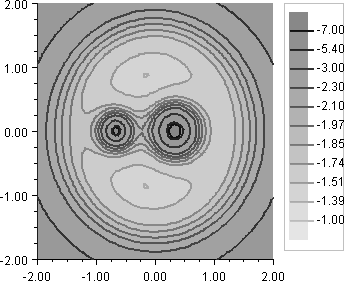In the center-of-mass coordinate system, the effective potential energy of the system is given by
import com.imsl.chart.*;
public class ContourEx1 extends javax.swing.JApplet {
private JPanelChart panel;
public void init() {
Chart chart = new Chart(this);
panel = new JPanelChart(chart);
getContentPane().add(panel, java.awt.BorderLayout.CENTER);
setup(chart);
}
static private void setup(Chart chart) {
int nx = 80;
int ny = 80;
// Allocate space
double xGrid[] = new double[nx];
double yGrid[] = new double[ny];
double zData[][] = new double[nx][ny];
// Setup the grids points
for (int i = 0; i < nx; i++) {
xGrid[i] = -2 + 4.0*i/(double)(nx-1);
}
for (int j = 0; j < ny; j++) {
yGrid[j] = -2 + 4.0*j/(double)(ny-1);
}
// Evaluate the function at the grid points
for (int i = 0; i < nx; i++) {
for (int j = 0; j < ny; j++) {
double x = xGrid[i];
double y = yGrid[j];
double rm = 0.5;
double x1 = rm / (1.0+rm);
double x2 = x1 - 1.0;
double d1 = Math.sqrt((x-x1)*(x-x1)+y*y);
double d2 = Math.sqrt((x-x2)*(x-x2)+y*y);
zData[i][j] = x2/d1 - x1/d2 - 0.5*(x*x+y*y);
}
}
// Create the contour chart, with user-specified levels and a legend
AxisXY axis = new AxisXY(chart);
double cLevel[] = {-7, -5.4, -3, -2.3, -2.1, -1.97, -1.85, -1.74, -1.51, -1.39, -1};
Contour c = new Contour(axis, xGrid, yGrid, zData, cLevel);
c.getContourLegend().setPaint(true);
}
public static void main(String argv[]) {
JFrameChart frame = new JFrameChart();
ContourEx1.setup(frame.getChart());
frame.show();
}
}
